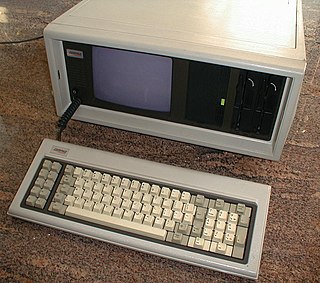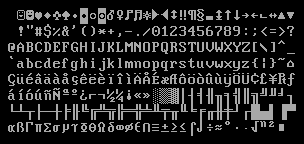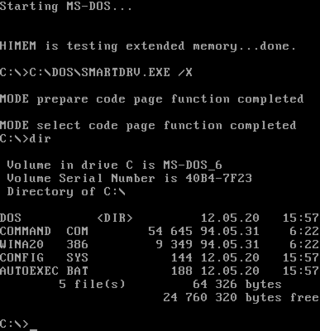
Microsoft Word is a word processing software developed by Microsoft. It was first released on October 25, 1983, under the name Multi-Tool Word for Xenix systems. Subsequent versions were later written for several other platforms including IBM PCs running DOS (1983), Apple Macintosh running the Classic Mac OS (1985), AT&T UNIX PC (1985), Atari ST (1988), OS/2 (1989), Microsoft Windows (1989), SCO Unix (1990), and macOS (2001).

WordPerfect (WP) is a word processing application, now owned by Corel, with a long history on multiple personal computer platforms. At the height of its popularity in the 1980s and early 1990s, it was the dominant player in the word processor market, displacing the prior market leader WordStar.

WordStar is a word processor application for microcomputers. It dominated the market in the early and mid-1980s, succeeding the market leader Electric Pencil. It was published by MicroPro International, originally written for the CP/M-80 operating system, and later written also for MS-DOS and other 16-bit PC OSes. Seymour I. Rubinstein was the principal owner of the company, and Rob Barnaby was the sole author of the early versions of the program. Starting with WordStar 4.0, the program was built on new code written principally by Peter Mierau.
XyWrite is a word processor for MS-DOS and Windows modeled on the mainframe-based ATEX typesetting system. Popular with writers and editors for its speed and degree of customization, XyWrite was in its heyday the house word processor in many editorial offices, including the New York Times from 1989 to 1993. XyWrite was developed by David Erickson and marketed by XyQuest from 1982 through 1992, after which it was acquired by The Technology Group. The final version for MS-DOS was 4.18 (1993); for Windows, 4.13.

CP/M, originally standing for Control Program/Monitor and later Control Program for Microcomputers, is a mass-market operating system created in 1974 for Intel 8080/85-based microcomputers by Gary Kildall of Digital Research, Inc. Initially confined to single-tasking on 8-bit processors and no more than 64 kilobytes of memory, later versions of CP/M added multi-user variations and were migrated to 16-bit processors.

IBM PC compatible computers are similar to the original IBM PC, XT, and AT that are able to use the same software and expansion cards. Such computers were referred to as PC clones, or IBM clones. The term "IBM PC compatible" is now a historical description only, since IBM no longer sells personal computers. The designation "PC", as used in much of personal computer history has not meant "personal computer" generally, but rather an x86 computer capable of running the same software that a contemporary IBM PC could. The term was initially in contrast to the variety of home computer systems available in the early 1980s, such as the Apple II, TRS-80, and Commodore 64. Later, the term was primarily used in contrast to Apple's Macintosh computers.

Ventura Publisher was the first popular desktop publishing package for IBM PC compatible computers running the GEM extension to the DOS operating system. The software was originally developed by Ventura Software, a small software company founded by John Meyer, Don Heiskell, and Lee Jay Lorenzen, all of whom met while working at Digital Research. It ran under an included run-time copy of Digital Research's GEM.

In computing, text-based user interfaces (TUI), is a retronym describing a type of user interface (UI) common as an early form of human–computer interaction, before the advent of graphical user interfaces (GUIs). Like GUIs, they may use the entire screen area and accept mouse and other inputs. They may also use color and often structure the display using special graphical characters such as ┌ and ╣, referred to in Unicode as the "box drawing" set. The modern context of use is usually a terminal emulator.
In digital typography, the TrueType font Arial Unicode MS is an extended version of the font Arial. Compared to Arial, it includes higher line height, omits kerning pairs and adds enough glyphs to cover a large subset of Unicode 2.1—thus supporting most Microsoft code pages, but also requiring much more storage space. It also adds Ideographic layout tables, but unlike Arial, it mandates no smoothing in the 14–18 point range, and contains Roman (upright) glyphs only; there is no oblique (italic) version. Arial Unicode MS was previously distributed with Microsoft Office, but this ended in 2016 version. It is bundled with Mac OS X v10.5 and later. It may also be purchased separately from Ascender Corporation, who licenses the font from Microsoft.

LocoScript is a word processing software package created by Locomotive Software and first released with the Amstrad PCW, a personal computer launched in 1985. Early versions of LocoScript were noted for combining a wide range of facilities with outstanding ease of use. This and the low price of the hardware made it one of the best-selling word processors of the late 1980s. Four major versions of LocoScript were published for the PCW, and two for IBM-compatible PCs running MS-DOS. LocoScript's market share didn't expand with the PC versions, which were not released until after Windows had become the dominant PC operating system.

Code page 850 is a code page used under DOS and Psion's EPOC16 operating systems in Western Europe. Depending on the country setting and system configuration, code page 850 is the primary code page and default OEM code page in many countries, including various English-speaking locales, whilst other English-speaking locales default to use the hardware code page 437.

Code page 437 is the character set of the original IBM PC. It is also known as CP437, OEM-US, OEM 437, PC-8, or DOS Latin US. The set includes all printable ASCII characters, extended codes for accented letters (diacritics), some Greek letters, icons, and line-drawing symbols. It is sometimes referred to as the "OEM font" or "high ASCII", or as "extended ASCII".
ANSI art is a computer art form that was widely used at one time on bulletin board systems. It is similar to ASCII art, but constructed from a larger set of 256 letters, numbers, and symbols — all codes found in IBM code page 437, often referred to as extended ASCII and used in MS-DOS and Unix environments. ANSI art also contains special ANSI escape sequences that color text with the 16 foreground and 8 background colours offered by ANSI.SYS, an MS-DOS device driver loosely based upon the ANSI X3.64 standard for text terminals. Some ANSI artists take advantage of the cursor control sequences within ANSI X3.64 in order to create animations, commonly referred to as ANSImations. ANSI art and text files which incorporate ANSI codes carry the de facto.ANS file extension.
Samna was a competitor to WordStar and MultiMate in the DOS market for word processors in the 1980s. Based in large part on the look and feel of the Lanier enterprise word processing system's software, Samna was targeted at businesses who had used the Lanier system but were interested in moving to lower-cost PC-based word processing. Samna was developed and published by Samna Corp., an Atlanta, Georgia, U.S.-based computer software company that was bought by Lotus Software in November 1990 for $65 million USD.
Sprint is a text-based word processor for MS-DOS, first published by Borland in 1987.
On personal computers with numeric keypads that use Microsoft operating systems, such as Windows, many characters that do not have a dedicated key combination on the keyboard may nevertheless be entered using the Alt code. This is done by pressing and holding the Alt key, then typing a number on the keyboard's numeric keypad that identifies the character and then releasing Alt.

Scripsit is a word processing application written for the Radio Shack TRS-80 line of computers. Versions were available for most if not all computers sold under the TRS-80 name, including the Color Computer and several pocket computer designs, as well as the Tandy version of the Xenix operating system. Tandy Corp. also produced a version running under MS-DOS for its line of PC compatible computers. Some of the 8-bit versions are tape-based and have no ability to read or write to disk.

DOS is a platform-independent acronym for disk operating system which later became a common shorthand for disk-based operating systems on IBM PC compatibles. DOS primarily consists of Microsoft's MS-DOS and a rebranded version under the name IBM PC DOS, both of which were introduced in 1981. Later compatible systems from other manufacturers include DR DOS (1988), ROM-DOS (1989), PTS-DOS (1993), and FreeDOS (1998). MS-DOS dominated the IBM PC compatible market between 1981 and 1995.

The first version of Microsoft Word was developed by Charles Simonyi and Richard Brodie, former Xerox programmers hired by Bill Gates and Paul Allen in 1981. Both programmers worked on Xerox Bravo, the first WYSIWYG word processor. The first Word version, Word 1.0, was released in October 1983 for Xenix and MS-DOS; it was followed by four very similar versions that were not very successful. The first Windows version was released in 1989, with a slightly improved interface. When Windows 3.0 was released in 1990, Word became a huge commercial success. Word for Windows 1.0 was followed by Word 2.0 in 1991 and Word 6.0 in 1993. Then it was renamed to Word 95 and Word 97, Word 2000 and Word for Office XP. With the release of Word 2003, the numbering was again year-based. Since then, Windows versions include Word 2007, Word 2010, Word 2013, Word 2016, and most recently, Word for Office 365.













